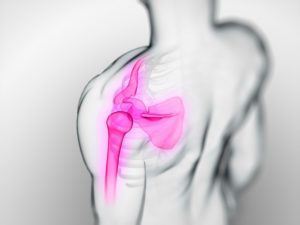Adult Stem Cell Therapy & Platelet Rich Plasma
The Three Most Common Shoulder Injuries and What Can Be Done
 Your shoulders have the largest range of motion out of all the joints in your body. We need our shoulders for all sorts of day-to-day tasks, from lifting large objects to pushing a shopping cart. Unfortunately, shoulder injuries are common and can lead to lasting pain. When a shoulder injury is holding you back from your favorite activities, it’s time to consult a medical professional for a personalized treatment plan.
Your shoulders have the largest range of motion out of all the joints in your body. We need our shoulders for all sorts of day-to-day tasks, from lifting large objects to pushing a shopping cart. Unfortunately, shoulder injuries are common and can lead to lasting pain. When a shoulder injury is holding you back from your favorite activities, it’s time to consult a medical professional for a personalized treatment plan.
Here, we’ll discuss the three most common shoulder injuries and the methods used to treat them.
Three Common Injuries: Instability, Arthritis, and Tendinitis
Shoulder Sprain or Dislocation
Shoulder sprain and shoulder dislocation are both cases of shoulder instability. These injuries commonly occur in athletes, who are more prone to overusing or overstretching muscles and ligaments in the shoulder. Also, younger people may be more likely to suffer shoulder instability because their still-growing bodies lack the strength, stability, and eventual stiffness that comes with age.
Should instability can happen when abnormal force is exerted on the shoulder, forcing the ligaments to stretch past their capacity. A shoulder sprain or dislocation may happen after a fall when you catch yourself with an outstretched arm. In the case of a shoulder sprain, the ligaments which attach the clavicle to the acromion are torn. A shoulder dislocation occurs when the ligaments that connect the bones of the shoulder joint are torn.
Shoulder Arthritis
There are two joints in the shoulder: the acromioclavicular joint and the glenohumeral joint, which may also be called the scapulothoracic joint. The acromioclavicular joint, or AC joint, is located where the clavicle (collarbone) and the acromion (shoulder bone) meet, while the glenohumeral joint is located where the humerus (upper arm bone) and the scapula (shoulder blade) meet. Either of these joints may develop arthritis.
Osteoarthritis, rheumatoid arthritis, and posttraumatic arthritis are the three main types of arthritis that may affect the shoulder area. Arthritis of the shoulder joints leads to pain, limited range of movement, and stiffness, which are generally exacerbated when you move the joints.
Rotator Cuff Tendinitis
Rotator cuff tendinitis can result from overuse, especially in athletes, or from an injury. It generally results in swelling and tenderness at the front of the shoulder, along with stiffness when you try to move the shoulder joint. Rotator cuff tendinitis will progressively become worse without treatment, leading to lost strength and range of motion, along with increased pain.
Shoulder Injury Treatments
Shoulder Sprain and Dislocation Treatments
Shoulder instability injuries can be treated by nonsurgical means, such as physical therapy to regain strength in the shoulder joint area, along with rest. However, sprains and dislocation also need immediate care, and ice should be applied to the area as soon after the injury as possible. A dislocation will require the help of a medical professional to pop the shoulder back into place.
Severe shoulder instability may require surgery. The expertise of an experienced orthopedic surgeon is needed to prevent the risk of recurrent shoulder dislocations.
Shoulder Arthritis Treatments
Shoulder arthritis may be treated with or without surgery. Nonsurgical treatments for this condition include PRP (plasma rich platelets), stem cells, physical therapy, lifestyle adjustments, moist heat, anti-inflammatory medications, dietary supplements, and rest.
When nonsurgical treatments aren’t effective, patients can turn to surgical treatment to reduce shoulder arthritis pain. Surgical treatment may involve a total shoulder arthroplasty, which means that the whole shoulder joint is replaced with a prosthesis, or a hemiarthroplasty, in which the head of the humerus is replaced. Resection arthroplasty is the most widely prescribed surgical treatment for shoulder arthritis and involves the removal of a small piece of bone from the end of the collarbone.
Rotator Cuff Tendinitis Treatments
Rotator cuff treatment typically starts with nonsurgical methods, including rest, anti-inflammatory medications, and physical therapy. These strategies aim to ease inflammation, reduce pain, and strengthen the shoulder area.
Surgical treatment may be required for severe rotator cuff tendinitis. The aim of surgical treatment is to increase space for the rotator cuff to move by removing the section of the bursa that’s inflamed. The acromion may also be removed in a procedure called anterior acromioplasty. Recovery from surgical procedures for rotator cuff pain can range from a few months to a year.
Conclusion
We all need healthy shoulders to go through our daily activities. When shoulder pain persists, whether as a result of injury or overuse, it’s essential to get medical attention as soon as possible. The insight of a seasoned orthopedic surgeon like Dr. Bennett will boost your chances for a full recovery from your shoulder injury.
Sources
https://www.urmc.rochester.edu/encyclopedia/content.aspx?contenttypeid=1&contentid=832






